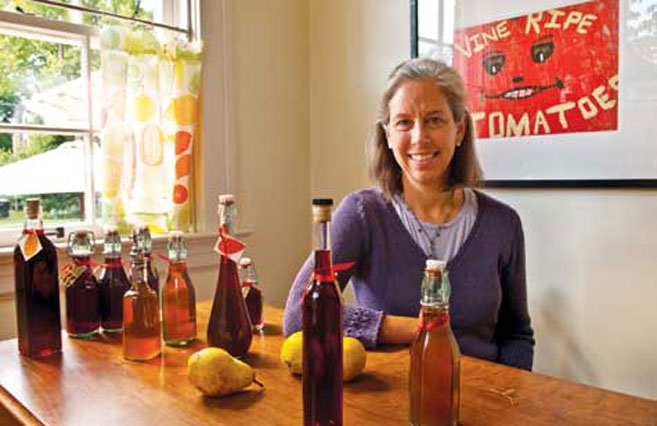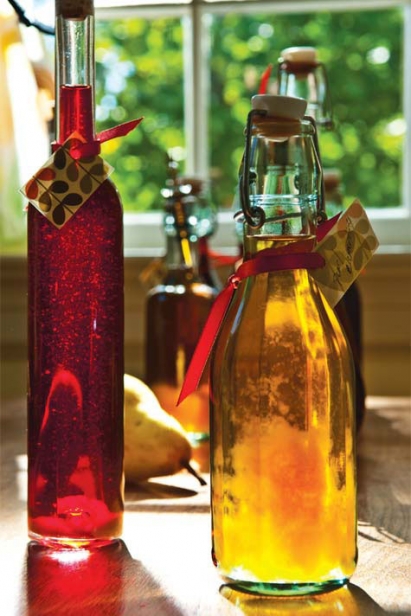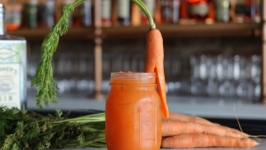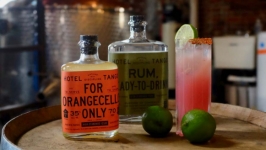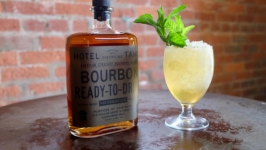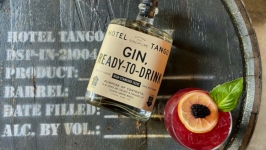Kentucky Cordials:
What could taste more ‘local’ than homegrown fruit steeped in bourbon?
In The Bluegrass Cookbook, released in 1904, there’s a recipe for a sweet, strong concoction called a Blackberry Cordial made with a gallon of blackberry juice, a pound of sugar, a tablespoon each of allspice and cloves — all boiled until it thickened, then cut with a quart of whiskey or brandy.
Similar, with less juice and more sugar, is a recipe in the ancient but undated My Old Kentucky Home Recipes book, compiled by the Nelson County Homemakers Clubs. The homemakers’ recipe was described as “medicinal” and “excellent for children when teething.”
Susan Hamilton’s cordials, which she started making in 2007, are strictly for adults. Equal parts fruit and bourbon (or maybe a little more bourbon), the mixture is sweetened with sugar and can be seasoned with herbs and/or citrus. Mixed during the growing season for whatever fruit she’s using, the macerating mixture is stashed in a dark, cool basement for several months, then strained and funneled into attractive bottles for serving after a big dinner or for giving as gifts. Sometimes, as with a mix of persimmon and tangerines, it sits on a dining room side table in a large glass urn, ready for marinating meats or pouring over ice cream. Susan can’t remember exactly when or why she started mixing cordials, or why, exactly, they caught her fancy so completely. She has asked professionals in the spirits and drink businesses to evaluate her versions. But around the time that she and her husband, Louisville architect Ed Krebs, bought a farm in Washington County, she ran across a cordial recipe in her mother’s old books. Wild blackberries on the farm presented an opportunity.
“When I first got started and was trying to figure out if people were making bourbon liqueurs,” she recalls, she asked the clerk at a local liquor store if he knew of any.
“Why would you want to ruin a good bourbon,” she recalls him saying. “That set me back a while.”
But eventually, she figured that though her mixtures used bourbon, they were a different product altogether. The blackberries from her farm played an important role, also.
“I wanted [the cordials] to be a product of here, sort of building on the bourbon that’s here.”
Though she grew up in Louisville, Susan, who now consults with people about how land is used, conserved and preserved, spent much of her youth in Bullitt County bourbon country. Her grandmother’s farm was nearly contiguous to the Four Roses Cox’s Creek facility. Heaven Hill and Jim Beam distilleries were nearby. The sight of trucks carrying spent distillery grains down country roads was common.
She went to college in Colorado, lingering afterwards to work. From there she moved to Vermont to attend law school and work. “When I moved back I realized how unique it was to have distilleries dotting the landscape,” she said, something she hadn’t realized while growing up among them.
The flavors of her cordials change from year to year and batch to batch, and Susan keeps a set of running notes in a computer document. She has cataloged more than a dozen blackberry combinations (blackberry mint, blackberry peach, blackberry cinnamon- clove, blackberry rosemary-mint, and so on), plus several pear combinations and several persimmon combinations. Persimmons make a murkier cordial and the solids hang on to more of the bourbon when it is strained, but Susan is crazy about the flavor and she’s always wondering how to work it out to be more suitable.
One of her most successful cordials was a mix of June apples from the farm and currants from a bush in the backyard of her Highlands home. She picked the currants when they were ripe and froze them until she could use them. Fresh currants are rare, however, and she hasn’t duplicated that one again, though she contemplates planting currant bushes at the farm.
Over the years, Susan has looked at cookbooks and magazines for recipes that suggest flavor combinations — pear and ginger, for instance. She’s used rosemary, mint and basil as seasonings in some of her mixtures. This summer’s batch of blackberry cordial made with lemon zest disappointed her with too much bitterness, though it makes a mean lemonade.
“There are ways to use the botched ones,” she says of her continuous trials.
She has experimented with sorghum and honey as sweeteners, which made the mixture cloudy. “I’d like to play around more with sorghum,” she says. “Pear and sorghum sounds good.”
The bourbon choice also makes a big difference, says Susan, and she has experimented with many different ones. She prefers a stronger flavor, with a lot of char, as opposed to softer, more refined types. Each quart Mason jar is a self-contained experiment: One can be made with berries and lemon zest, the next one with berries and tangerine. Susan might sweeten one with rosemary-seasoned simple (sugar) syrup, while the next jar might contain a spring of rosemary that remains for months. As she’s straining and bottling the mixtures, Susan tastes them and makes notes. One from this year: “Disappointing. Bitter.
Too much lemon with not enough sugar. Grassy … too much blackberry plant material or lemon rind?? Too much lemon!” (But fortunately, great in a spiked lemonade.) Another reads, “Actually, this is good. Less zest because used a lime instead of a lemon. More sugar. Might be getting lemon rind in the jar, rather than just zest.”
At home, some of the strained mixtures are in jars that formerly held commercially prepared products, but for gift giving or for pulling out after a dinner party, Susan uses a funnel with an extra-long neck to package them in decorative bottles she’s found at stores like T.J. Maxx and World Market, or repurposed vinegar bottles.
She’s read that the mixtures are safe “up to 10 months,” so she tries to pass them on when they are just a few months old. But she and her husband drink them long after their “past due” date, she says.
The experiments continue. “I’d like to try paw-paws,” says Susan, though she thinks they may present a murkiness problem like persimmons. “I would love to play more with recipes. I’d love to play with cocktails,” using the cordials to flavor club soda or champagne or mix with spirits. Her experiments are always guided by food that’s native here, or easy to grow here — persimmons, Seckel pears, apples and blackberries. The point is for the cordials “to be about our region and about this place,” says Susan
RECIPES
Pear Cordial with Spices
Wild Blackberry Cordial
Persimmon/Tangerine with Spices
PEAR CORDIAL WITH SPICES
This recipe, bottled Feb. 9, 2012, is “very good. Orange-ey. Less pear. Not too sweet despite the increase of sugar over the pear one with rosemary syrup,” according to Susan’s notes.
Ingredients
- ½ cup sugar
- 3-inch vanilla bean, sliced lengthwise
- 1 generous tablespoon Clementine zest
- ½ teaspoon chopped fresh ginger
- 2 Seckel pears, peeled and cut in chunks (include peel)
- 2 to 3 cups bourbon, to fill jar
Instructions
- Combine sugar, vanilla bean, zest, ginger and pears in a 1-quart Mason jar or other wide-mouthed jar. Fill with bourbon of choice. Screw top on jar. Shake to dissolve sugar. Store in a dark, cool place (like a basement) for several months, shaking it a few times during the first weeks of standing. Strain twice through cheesecloth and discard solids (or save for another use). Bottle and date.
WILD BLACKBERRY CORDIAL
Assembled July 15, 2007, this was described in Susan’s notes as “Very good. Fresh berry flavor, but not too sweet.”
Ingredients
- 2¼ cups wild blackberries
- ⅔ cup sugar
- 1½ cups bourbon, and more, to fill the jar
Instructions
- Combine blackberries and sugar in a 1-quart Mason jar or other wide-mouthed jar. Fill with bourbon of choice. Screw top on jar. Shake to dissolve sugar. Store in a dark, cool place (like a basement) for several months, shaking it a few times during the first weeks of standing. Strain through cheesecloth and discard solids. Bottle and date.
PERSIMMON/TANGERINE WITH SPICES
Assembled in December 2008, this combination is described in Susan’s notes as “Delicious straight out of jar (2/22/09). Tangerine is especially good. Tried to strain pulp—difficult. Cloudy. Need to figure out a better technique. Might want to try stronger spices. Allspice? Cloves??
Ingredients
- 1 cup persimmon pulp
- ½ tangerine, sectioned, divided and cut in half
- ⅔ cup sugar
- ½ stick cinnamon
- ¼ teaspoon coriander
- 2 to 3 cups bourbon, to top off jar
Instructions
- Combine pulp, tangerine, sugar, cinnamon and coriander in a 1-quart Mason jar or other wide-mouthed jar. Fill with bourbon of choice. Screw top on jar. Shake to dissolve sugar. Store in a dark, cool place (like a basement) for several months, shaking it a few times during the first weeks of standing. Strain through cheesecloth, pressing to squeeze bourbon out of pulp. Bottle and date.


